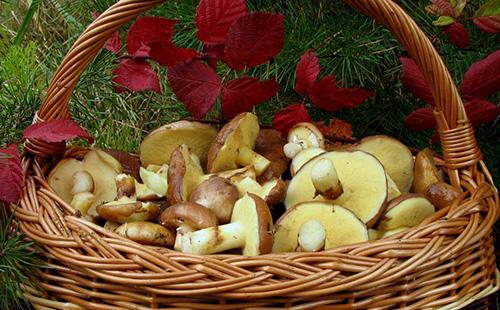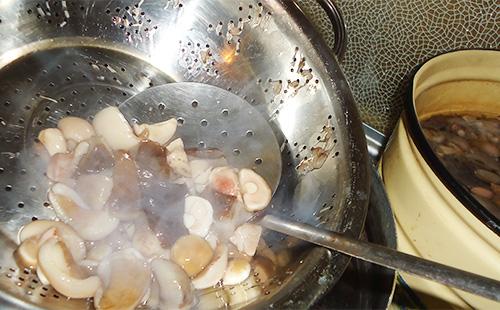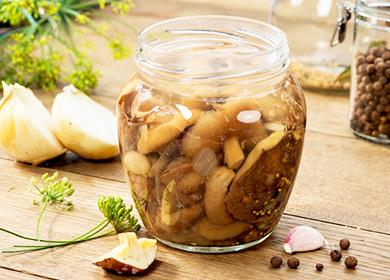Those who at least once dealt with oils, it immediately becomes clear why these mushrooms received such a name. Their hats are covered with a shiny film that has an oily texture. If you cut the mushroom in half, inside you will see a yellow-white pulp, which also causes associations with butter. In some regions, the name of the fungus sounds slightly different, but it is certainly associated with oil: “masleha”, “Pancake week”, “butterfish”. It has long been a favorite of mushroom pickers due to its pleasant texture, mouth-watering taste and an abundance of simple pickling recipes.
The effect of the product on the body
Before you include a product in your diet, it will be worthwhile to find out about the specifics of its effect on the body. It's nice when your favorite food makes you healthier. But do not forget about contraindications.
Composition and benefits
Oil cans are low-calorie foods (only 19 kcal per 100 g). Despite the fact that 85-95% of the product consists of water, it contains many vitamins and minerals. Scientists came to the conclusion that the protein contained in the oils is very similar to the animal. Therefore, such mushrooms are recommended for people who are on a diet or fasting. The product is characterized by a rich chemical composition, the description of which is given in the table.
Table - Nutrient nutrients
| Substance | Amount, mg / 100g | The share of the daily norm,% | Effect on the body |
|---|---|---|---|
| Vitamin B1 | 0,03 | 2 | - Stimulates metabolic processes; - promotes glucose transport; - normalizes heart rate; - strengthens the walls of blood vessels |
| Vitamin B2 | 0,27 | 15 | - Participates in the synthesis of red blood cells and hemoglobin; - strengthens the immune system; - stimulates the production of antibodies and macrophages; - activates metabolism; - relieves nervous tension; - normalizes the condition of tissues and mucous membranes; - stimulates the production of thyroid hormones |
| Vitamin B6 | 0,3 | 15 | - Lowers cholesterol; - stabilizes the central nervous system; - stimulates the synthesis of red blood cells; - normalizes water balance; - activates brain activity; - cleanses the body of toxins; - normalizes the level of sex hormones |
| Vitamin B9 | 0,03 | 8 | - Normalizes the work of the heart and blood vessels; - strengthens the immune system; - contributes to the normal course of pregnancy |
| Vitamin C | 12 | 13 | - Stimulates the synthesis of its own collagen; - cleanses the body of toxins; - supports the normal functioning of the liver; - strengthens the immune system; - has an anti-inflammatory effect; - accelerates tissue regeneration |
| Vitamin PP | 4 | 20 | - Stimulates the transformation of fats and carbohydrates into energy; - lowers cholesterol; - normalizes the digestive tract; - normalizes the production of sex hormones |
| Vitamin D | 0.05 | 40 | - Participates in bone growth; - normalizes blood coagulation; - strengthens the immune system; - prevents muscle weakness; - struggles with chronic fatigue; - suppresses inflammatory processes |
| Iron | 4 | 7 | - Participates in the synthesis of hemoglobin; - facilitates cellular respiration; - normalizes the liver; - lowers cholesterol; - stimulates the synthesis of thyroid hormones; - improves the functional state of the skin |
| Phosphorus | 57 | 7 | - Normalizes energy metabolism; - dulls pain with arthritis; - strengthens bones and tooth enamel; - accelerates metabolism; - normalizes acid-base balance |
| Potassium | 506 | 20 | - Normalizes the water-salt balance; - accelerates the process of transmission of nerve impulses; - activates the work of enzymes; - normalizes kidney function; - normalizes intestinal motility |
| Zinc | 0,71 | 6 | - Accelerates metabolism; - strengthens the immune system; - fights infections; - accelerates cell regeneration; - contributes to the normalization of memory; - supports visual acuity; - normalizes the reproductive system |
| Manganese | 0,3 | 15 | - Takes part in the transmission of nerve impulses; - neutralizes free radicals; - stimulates the growth of muscle tissue; - promotes bone formation; - regulates blood sugar; - prevents fatty degeneration of the liver; - stimulates the production of female sex hormones |
| Selenium | 0,002 | 4 | - Strengthens the immune system; - reduces pain with arthritis; - reduces the risk of ischemia; - stimulates reproductive function |
Contraindications
Despite the fact that butterflies are considered one of the most useful mushrooms, there are contraindications to their use.
- Gastrointestinal diseases. In mushrooms, there is a lot of fiber saturated with quinine. The substance impedes digestion and irritates the gastric mucosa.
- Individual intolerance. Mushrooms are allergenic foods. Their use can cause rashes and other manifestations of the negative reaction of the body.
- Pregnancy, lactation and children under seven years of age. Of all the mushrooms, oleagins have the most pronounced absorbent properties. They can accumulate harmful radionuclides. This negatively affects the development of the child.

Memo for beginner mushroom pickers
Walking through the supermarkets, fresh butter you will not meet. Unless marinated in glass jars. If you want to make a blank yourself, you will have to “hunt” for raw materials. Experienced mushroom pickers know well where, when and which mushrooms to pick. And beginners will have to start with theory.
Oil mushrooms are tubular mushrooms that belong to the Boletovy family. They grow in groups within a radius of 2 m from the trees, so finding and collecting them is easy enough. There are more than 50 types of olives, but not all can be found in domestic latitudes and not all are safe. The table provides information on the most common edible types of oils.
Table - Description of edible types of oil
| View | Description | Collection period | Where to collect |
|---|---|---|---|
| Bellini | - Smooth hemispherical hat of white or brown color with a diameter of 6-14 cm; - short massive leg 3-6 cm high, curved at the base | August-November | In the pine forests |
| Belted (Clinton) | - Smooth convex hat of brown color with a diameter of 5-15 cm; - long leg 5-12 cm high; - a two-layer ring (externally membranous, and inside the mucous membrane) | July-October | In places of growth of Siberian larch |
| Swamp (yellowish) | - Smooth convex hat of dirty yellow or ocher color; - the leg is thin and dense; - gray-yellow hymenophore; - jelly ring texture | May-November | In mixed and coniferous forests on sandy soils |
| Granular (summer, early) | - Smooth convex hat of brown or ocher color with a diameter of 2-20 cm; - a dense leg 4-8 cm high with granular nodules; - accreted hymenophore white-yellow | June-October | In places of growth of common pine on sandy soils, clearings, along roads |
| Common (late, yellow, present, autumn) | - Smooth, strongly mucous convex or flat hat of brown color with a diameter of 3-14 cm; - longitudinally fibrous leg 3-11 cm high; - The grown hymenophore of yellow color; - black brown film ring | June-October (peak yield in September) | In pine, pine-birch, pine-oak forests with sandy soil under coniferous litter or in heather thickets (next to russula, chanterelles, porcini mushrooms) |
| White (pale, soft) | - Smooth convex, flat or concave hat is pale yellow in diameter with 5-12 cm; - a cylindrical or spindle-shaped leg of curved shape with a height of 3-9 cm; - accreted or descending hymenophore of white-yellow or olive color | June-November (peak yield in August-September) | In mixed forests, where European cedar grows, weimouth pine, Siberian cedar, cedar elfin |
| Yellow-brown (variegated, sandy) | - Convex scaly hat of olive, yellow, orange or brown color with a diameter of 6-10 cm; - smooth thick leg 3-9 cm high; - adhered gimenofor orange, brown or yellow-olive color | June-November | In mixed and coniferous forests on sandy soils |
*** Gimenofor - the inner surface of the cap of the mushroom.
Cooking technology
If you learn to salt the butter, you will never have problems with how to consume a rich crop of mushrooms, and on the shelf there will always be a couple of cans with a delicious snack for fried potatoes or alcohol. And the workpiece can be used for salads, as a filling for pancakes, pizza, tartlets.
Raw material preparation
Oil cans are a perishable product. They should be processed immediately after collection, having previously been laid out in a single layer on newspapers or dry cloth. If there is no time, you can put the "crop" in the refrigerator, but not more than 12 hours. Next, prepare the raw materials, which involves six steps.
- Hand protection. First put on household or medical gloves. Mushroom juice stains the skin and nails in a dark brown color, which is then very difficult to remove.
- Cleaning up. Lubricants should be cleaned dry. If you pre-soak them in water, they will become terribly slippery and it will be practically impossible to remove the film from them. And from a dry hat and legs, it leaves easily. It is enough to pry the film with a small sharp knife. You also need to cut off the lower part of the leg and all the darkened areas from the mushroom.
- The washing up. To remove the remains of sand and forest debris, you need to place mushrooms in a basin with cold water with a small amount of salt for half an hour. After that, rinse the oil under the tap another three to four times.
- Preparation for cooking. Large mushrooms are best cut into two or four parts, depending on size. Small can be cooked unchanged.
- Cooking. Dip the mushrooms and peeled onion in salted water, add a couple drops of vinegar so that the flesh does not darken, and bring to a boil. Opinions differ on cooking time. Someone believes that five minutes is enough, and someone claims that you need to cook mushrooms for at least 40 minutes. As practice shows, 20 minutes is enough for the butter to cook and acquire a pleasant crunch.
- Drying out. Throw the mushrooms in a colander so that they are completely glass of water. The broth needs to be poured, and the bulb discarded.

Canning
In order for the workpiece to be stored for a long time and delighted with a bright taste for a whole year, you must strictly adhere to the technology consisting of six stages.
- Cooking marinade. In an enameled pan, boil water with spices.
- Mushroom processing. Dip the prepared mushrooms in a pan with marinade and boil for a quarter of an hour.
- Additional ingredients. Add a preservative (vinegar or citric acid) and additional spices to the pan. Boil another ten minutes.
- Filling cans. Remove the mushrooms from the pan with a slotted spoon and distribute them in jars.Top with hot marinade. It is better to preserve in a half-liter container.
- Sterilization. Lay a towel at the bottom of a large pan, place the jars and cover them with seaming lids. Pour water into the pan so that to the edge of the cans there remains 1.5-2 cm. From the moment of boiling, a half-liter can is sterilized for 30 minutes, and a liter - 40 minutes.
- Sunset. Roll up the jars, wrap them in a warm blanket, and leave them in this form for two days. Move the workpiece for storage to a pantry or other cool place.
Recipe Table
To make the workpiece tasty, you need to add a few spices and spices. The table shows the popular recipes. The ingredients for the marinade are indicated per 1 liter of water. This volume of liquid is enough for 1-1.5 kg of prepared mushrooms.
Table - Recipes marinating butter
| Recipe | For marinade | Preservative | Extra spices |
|---|---|---|---|
| Classical | - 60 g of salt; - 40 g of sugar; - 2 bay leaves | 10 ml of vinegar essence | - 10 g of coriander; - 6 peas of black pepper; - 6 clove inflorescences |
| Cinnamon | - 20 g of salt; - 25 g of sugar; - 4 bay leaves; | 5 g of citric acid | - 2 inflorescences of cloves; - 3 g of cinnamon; - 6 peas of black pepper |
| With horseradish | - 35 g of salt; - 15 g of sugar; | 30 ml vinegar | - 2 umbrellas of dry dill; - 6 cloves of garlic; - 25 g horseradish |
| With mustard | - 20 g of salt; - 15 g of sugar; - 5 bay leaves | 25 ml vinegar | - 15 g of mustard seeds; - 5 cloves of garlic; - 5 peas of allspice |
| With ginger | - 30 g of salt; - a tablespoon of grated ginger; | - 100 ml of wine vinegar; - a tablespoon of lemon juice | - 5 cloves of garlic; - 2 carnation inflorescences |
Express snack
If there is no time or desire to make complex manipulations in the kitchen, you will need a recipe for pickled instant butter. In this way, you can cook both boiled and frozen mushrooms.
You will need
- 1 kg of prepared oil;
- glass of water;
- seven cloves of garlic;
- bulb;
- 25 g seasoning for Korean carrots;
- 7 g of paprika;
- 12 g of salt;
- a quarter cup of vinegar;
- a glass of vegetable oil.
Cooking
- Chop the onions finely and fry in oil until golden brown.
- Add loose ingredients, vinegar to the water and bring to a boil.
- Combine the marinade with oil and onion and pour the mixture of mushrooms.
- Tighten the container with the film and send it to the refrigerator for a day.
- Transfer the oil to the jar and close the lid.

Buying canned foods
Being a mushroom picker is a talent. You need to know where and when to pick mushrooms, how they look and how to distinguish a good product from a poisonous one. If you are not confident in your knowledge, you should not risk it. It is better to purchase ready-made pickled butter. Pay attention to six parameters.
- Packaging. Mushrooms should be packaged in transparent glass jars, allowing a good view of the contents. If the container is ribbed or has a large label that makes it difficult to evaluate the product, it is better to refuse the purchase.
- Marinade. Must be transparent. If it is dark, then the mushrooms are not peeled. There should not be traces of sand or any forest debris at the bottom.
- Main product. The bank should have at least 60% mushrooms. It is important that the oil is the same size. The smallest are the tastiest.
- Composition. In addition to mushrooms, only spices, salt, sugar and vinegar should be present in the jar. There should be no synthetic flavors or preservatives.
- Date of manufacture. Must coincide with the mushroom picking period. This is the middle of summer - the end of autumn.
- Cap. Must be closed tightly. If it is swollen, rusty or deformed, harmful microorganisms can live in the bank.
It is not forbidden to preserve oil in tandem with other "relatives".Slippery mushrooms go well with boletus, boletus, mushrooms, chanterelles, mushrooms and mushrooms.

